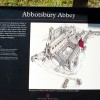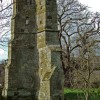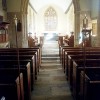Dorset has given birth to several prominent men in the world of medicine, but probably the earliest of these was Francis Glisson, born the second son of William Glisson at Little Rampisham in 1597. Although it is known that his early education was at Mr Allot’s school in Rampisham, the family history and early life of Francis Glisson is otherwise obscure. However when he was twenty in 1617 he entered Caius College, Cambridge, graduating in 1621 with a BA, and then proceeding to take an MA in 1624. His academic study was further advanced with his incorporation as MA at Oxford in 1627, going on to take an MD at Cambridge in 1636.
Having qualified as a physician, Glisson remained in Cambridge for the next four years, lecturing on comparative anatomy and physiology. During these years he was also elected to a lectureship on these subjects at the College of Physicians in London. About 1640 he moved to Colchester, but when Cromwell’s army besieged that town in 1648 during the Civil War, he was appointed as mediator to General Fairfax. This proved unsuccessful as a number of houses were burnt down, though Glisson’s was not among them. But with Colchester impoverished and in ruins, Glisson resolved to move to London. The capital would remain his home base for the rest of his life.
When he reached London, Glisson leased a house in the parish of St. Bride, Fleet Street. Here he had ample unhindered opportunity to devote his energies to epidemiological study, since he never married and so had no family commitments. He continued his active schedule of lectures often in other places around the country, including several visits to his native Dorset. It was in this county that he first became aware of the deformative condition known as rickets in the children of poor labourers, an observation which led him to devote much time to the study of this “new” disease, though it was known to a Roman Physician as early as 98AD.
Glisson had noticed that the main symptoms in children were misshapen bones and enlarged joints, but at that time no-one had any real idea of the cause. But Glisson may have been the first to suspect that rickets had something to do with a deficiency in the diet, although he thought that over-feeding was a likely cause. By this time Glisson had become respected and admired by his contemporaries as a writer on childhood diseases, and proposed that a greater consumption of milk and other dairy foods could prevent the condition, which it is now known is caused by lack of vitamin D.
In 1650, Glisson published ‘The Treatise on Rickets,’ his definitive work on the disease, based on the cumulative data of five years of study. This work, which ran to 416 pages of original observations, won great acclaim in the medical establishment. Even today, over three hundred years later, there is little to add about the disease.
By nature Glisson was a forceful character as well as a brilliant medical man. For example, it is recorded that he tenaciously demanded payment of arrears in his salary while Professor at Cambridge after he had not been paid for five years. He persisted until an order in council was issued in Whitehall ordering payment to be made.
At 53 Glisson had made a firm mark on the scientific establishment and his fame had spread widely. But his duties in Cambridge were becoming restricted by the widening scope of his interests. He therefore appointed, in 1675, the Master of Caius, Dr Brady, as deputy Professor of Physic. Glisson himself was deeply involved in the College of Physicians where, since 1656 he had been censor. This post was followed by a two-year term as President of the CoP from 1667. On leaving the Presidency Glisson donated £100 to the College Building Fund to help relieve a shortfall caused by the theft from the treasure chest in the plague year of 1665 and to restore the college building destroyed in the Great Fire the following year.
One way in which Francis Glisson showed that his interests were not confined to physiology was his membership of an elite band, which held meetings of enquiry into natural and experimental philosophy. From this sprang the foundation of the Royal Society, with Francis as one of its first fellows.
Francis Glisson was foremost a doctor and anatomist, turning his attention next to the physiology of the liver. ‘Anatomia Hepatis’ described in meticulous detail the normal and morbid structure of the liver, particularly its fibrous membrane, which was likened to a bag, and ever after known as ‘Glisson’s Capsule’ in his honour. Glisson was doctor and friend to Anthony Ashley, 1st Earl of Shaftesbury, whose patronage and help at various times he appreciated. Dr. Glisson was also physician to the Earl’s family.
An entirely different work by Francis Glisson followed in 1672 with the publication of ‘Tractatus de Natura Energetics,’ a deeply erudite investigation into Aristotelian philosophy. The work was dedicated to Earl Ashley and reflects Glisson’s love of scholarship to a greater degree than his earlier writings. Ten years before its publication the London Society had been granted a charter by Charles II at its Gresham College home. Here, early fellow members included Thomas Willis, Robert Boyle, Sir Christopher Wren and first president, Lord Brouncker.
Even at the age of 75 Glisson was still writing. Drawing on a lifetime’s experience of lecturing, ‘Tractatus de Ventriculo et Intestinis’ was his last treatise, which he dedicated to Cambridge University and the CoP, with whom he had been associated for so long.
Francis Glisson died in October 1677 and was buried in St. Bride’s Church. Thus the man from such humble beginnings in a Dorset village became one of the country’s outstanding scientists of materia medica. Doubtless his monument in the Fleet Street church is a fittings memorial to this eminent Dorestian who never returned to cross the divide on his native patch of Wessex.



